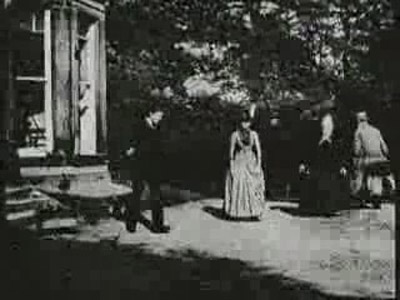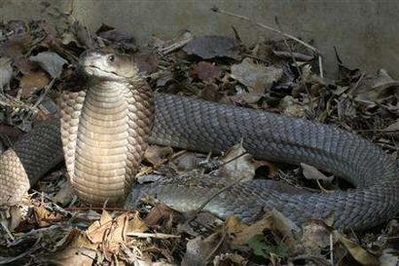
Roundhay Garden Scene

1888
Directed by Louis Aimé Augustin Le Prince

Roundhay Garden Scene is one of those movies that you hear about but just need to experience. It is a visual sensation unlike any other. Oh, wait, no it’s not, it is just some people walking around for two seconds. However, as it is the earliest film made, it has a place in history that no other film can match. That will not save it from getting its just desserts here on TarsTarkas.NET!

 |
Louis Aimé Augustin Le Prince – The director isn’t getting out of this easily. He has a long name, and that’s just ridiculous. Plus, he’s French. The biggest thing is how he went and vanished off the face of the Earth. Yep, he did a Houdini, except didn’t bother to make himself reappear. Many people have speculated what happened to him after he disappeared on a train in 1890, but a photo found in 2003 in the Paris police archives of a drowning victim looks a lot like Le Prince, so we’ll just call it case closed. Obviously he drowned on a train. |
 |
Adolphe Le Prince – Director Louis Le Prince’s son has the most prominant part in the film, walking about like a thing that walks about. Adolphe Le Prince was named for the famed German dictator thanks to his father’s other famous invention, the time machine. Le Prince also shares his father’s interest in having a mysterious death, because he turned up shot dead in 1902 in Fire Island, New York while duck hunting. Called a suicide, he was actually secretly murdered by Thomas Edison over the Equity 6928 brief. (Look it up!) |
 |
Sarah Robinson Whitley – This black-coat wearing old biddy is walking backwards, showing that even the earliest film has failed jokes. This joke was so bad it proved to be her undoing, as on October 24, 1888 (ten days after being filmed) she died at age 72. She was director Le Prince’s mother-in-law. |
 |
Joseph Whitley – His coattails are flapping because he’s a dancing fool! Joseph Whitley is also director Le Prince’s father-in-law, which would make him the husband of Sarah Robinson Whitley, and he seems awfully happy for someone who is about to be a widower in ten days. Very suspicious. |
 |
Harriet Hartley – Virtually nothing is known about this woman. Therefore, we will make stuff up. Harriet Hartley was the long-lost cousin of Harriet Tubman, she escaped on the Underground Railroad all the way to France. Hartley was instrumental in the dissolution of the Prussian government in post-WW1 Europe, and even discovered the element Hafnium. Hartley was killed in a tragic dirigible accident when someone thought it would be a good idea to bring a chimp on a dirigible. |
|
Some people think I’m crazy for going after a 119-year-old film with no sound. “It’s the first film made, cut it some slack!” they insist. Well, they’re wrong, why should it get a free pass just because no one knew what they were doing back then? They should have known better! Director Louis Aimé Augustin Le Prince should have considered his role in cinematic history, and the fact that generations later we would still have to look at the mess he made! Garbage, complete garbage! Where is the plot? The characterizations? The color? The sound? The length beyond two seconds? Is this what passed for entertainment in 1888, right before you died of the pocks or consumption? Well, those ragamuffins and mudsill who spend their coppers to see some moving pictures deserve better. Maybe someone should use an Arkansas toothpick to give someone Jesse, which would add some excitement to the film. That would make it a huckleberry above a persimmon, instead folks are likely to go to the quilting bee or the husking frolic.

Sorry for slipping into 19th century slang there for a moment, feel free to Google those terms to find out I wasn’t just honey-fuggling you with nonsense vocabulary. So the film is basically just Adolphe Le Prince walking while Sarah, Joseph, and Harriet mill about in the background. Filmed on October 14th, 1888, it was recorded on 1885 Eastman Kodak paper base photographic film with Le Prince’s single-lens combi camera-projector. The original film does not survive, all current prints are copies made around 1930, so this is like a second generation VHS dub. Bootleg city. Not that I would ever do that.

Le Prince’s disappearance pretty much set the stage for Edison to become the only person people think of when they think of who invented the movies. It is very suspicious. One would think Edison invented the first light bulb just so he could have it flash on above his head as he got the idea to have Le Prince have an “accident.” All the mysterious deaths surrounding this film is just proof that the movie industry was created morally bankrupt, and it’s been downhill from there!
That’s it, it is history, and we are all better for it. Without Roundhay Garden Scene we wouldn’t have Casablanca. We wouldn’t have The Marx Brothers. We wouldn’t have King Kong. We wouldn’t have Shark Attack 3: Megalodon. We wouldn’t have Catman in Boxers Blow. Damn you, Le Prince!

Director Le Prince went on to make Leeds Bridge, which was a failure at the box office and began the movie slump of 1888. The MPAA blamed internet downloaders and their iKinetoscopes.
Thanks to the magic of public domain, you can watch this classic film in its entirety!

[flowplayer id=”23419″]
And when you’re done with that, check out all these neat remixes done by the Something Awful Forums! Roundhay Garden Scene Deleted Scenes
Rated 4/10 (Roundhay, Garden, Scene, 1888)







Please give feedback below!
Email us and tell us how much we suck!























